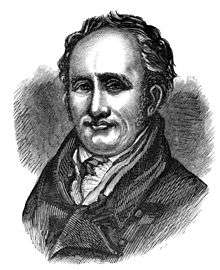Archibald Constable

Archibald David Constable (24 February 1774 – 21 July 1827) was a Scottish publisher, bookseller and stationer.
Life
Constable was born at Carnbee, Fife, son of the land steward to the Earl of Kellie.[1]
In 1788 Archibald was apprenticed to Peter Hill, an Edinburgh bookseller, but in 1795 he started in business for himself as a dealer in rare books. He bought the Scots Magazine in 1801, and John Leyden, the orientalist, became its editor. In 1800 Constable began the Farmer's Magazine, and in November 1802 he issued the first number of the Edinburgh Review, under the nominal editorship of Sydney Smith; Lord Jeffrey, was, however, the guiding spirit of the review, having as his associates Lord Brougham, Sir Walter Scott, Henry Hallam, John Playfair and afterwards Lord Macaulay.[1]
Constable made a new departure in publishing by the generosity of his terms to authors. Writers for the Edinburgh Review were paid at an unprecedented rate, and Constable offered Scott 1000 guineas in advance for Marmion. In 1804 A. G. Hunter joined Constable as partner, bringing considerable capital into the firm, styled from that time Archibald Constable & Co. In 1805, jointly with Longman & Co., Constable published Scott's Lay of the Last Minstrel, and in 1807 Marmion.[1]
In 1808 a split took place between Constable and Sir Walter Scott, who transferred his business to the publishing firm of John Ballantyne & Co., for which he supplied most of the capital. In 1813, however, a reconciliation took place. Ballantyne was in difficulties, and Constable again became Scott's publisher, a condition being that the firm of John Ballantyne & Co. should be wound up at an early date, though Scott retained his interest in the printing business of James Ballantyne & Co.[1]
In 1812 Constable, who had admitted Robert Cathcart and Robert Cadell as partners on Hunter's retirement, purchased the copyright of the Encyclopædia Britannica, adding the supplement (6 vols, 1816-1824) to the 4th, 5th and 6th editions. In 1814 he bought the copyright of Waverley. This was issued anonymously; but in a short time 12,000 copies were disposed of, Scott's other novels following in quick succession. The firm also published the Annual Register.[1]
Through over-speculation, complications arose, and in 1826 a crash came. Constable's London agents stopped payment, and he failed for over £250,000, while James Ballantyne & Co. also went bankrupt for nearly £90,000. Sir Walter Scott was affected by the failure of both firms.[1]
Constable started business afresh, and began in 1827 Constable's Miscellany of Original and Selected Works consisting of a series of original works, and of standard books republished in a cheap form, thus making one of the earliest and most famous attempts to popularize high-quality literature. [1]

Constable died on 21 July 1827,[2] but his firm survived,[1] and the Constable publishing business continued in the twentieth century, issuing a wide range of fiction and non-fiction books. It continues today as Constable & Robinson.
Family
Constable was married to Mary Willison. They lived in Craigcrook House in western Edinburgh.[3]
Their son, Thomas Constable FRSE (1812-1881) took over his printing business on his father's death. In 1839 he was appointed printer and publisher in Edinburgh to Queen Victoria, and issued, among other notable series, Constable's Educational Series, and Constable's Foreign Miscellany. In 1865 his son Archibald David Constable (died 1915) became a partner, and when Thomas retired in 1893 the firm continued under the name of T. & A. Constable.[4][5]
Thomas married Lucia Anne Cowan, daughter of Alexander Cowan paper-maker (who clearly would have had business links with a major publishing firm such as Constables).[6] They lived at 11 Thistle Street in Edinburgh's First New Town.[7] Their son was also Archibald David Constable FRSE LLD (1843-1915), named after his grandfather, and followed in the family tradition as a printer.
His daughter, Elizabeth Constable (d.1818) married his junior publishing partner, Robert Cadell of Ratho.[8]
See also
Notes
- 1 2 3 4 5 6 7 8 Chisholm 1911, p. 981.
- ↑ Archibald Constable and his Literary Correspondents, by his son Thomas Constable (3 vols., 1873). This book contains numerous contemporary notices of Archibald Constable, and vindicates him from the exaggeration of J. G. Lockhart and others (Chisholm 1911, p. 982).
- ↑ Waterston & Shearer 2010, p. 200.
- ↑ Chisholm 1911, p. 982.
- ↑ Waterston & Shearer 2010, pp. 199–200.
- ↑ Dictionary of National Biography: Thomas Constable
- ↑ "List of the Ordinary Fellows of the Society". 26 (01). 1 January 1870: xi–xiii. doi:10.1017/S008045680002648X – via Cambridge Journals Online.
- ↑ Monuments and monumental inscriptions in Scotland: The Grampian Society, 1871
References
- Waterston, C D; Shearer, A Macmillan (8 November 2010), Former Fellows of The Royal Society of Edinburgh 1783 – 2002 (PDF), Royal Society of Edinburgh
Attribution:
-
 This article incorporates text from a publication now in the public domain: Chisholm, Hugh, ed. (1911), "Constable, Archibald", Encyclopædia Britannica, 6 (11th ed.), Cambridge University Press, pp. 981–982
This article incorporates text from a publication now in the public domain: Chisholm, Hugh, ed. (1911), "Constable, Archibald", Encyclopædia Britannica, 6 (11th ed.), Cambridge University Press, pp. 981–982
Further reading
 Henderson, Thomas Finlayson (1887). "Constable, Archibald". In Stephen, Leslie. Dictionary of National Biography. 12. London: Smith, Elder & Co. pp. 32–33.
Henderson, Thomas Finlayson (1887). "Constable, Archibald". In Stephen, Leslie. Dictionary of National Biography. 12. London: Smith, Elder & Co. pp. 32–33. - Hewitt, David (January 2007) [2004]. "Constable, Archibald (1774–1827)". Oxford Dictionary of National Biography (online ed.). Oxford University Press. doi:10.1093/ref:odnb/6101. (Subscription or UK public library membership required.)
Published by Constable & Co.
- Edinburgh Gazetteer. Edinburgh: A. Constable & Co. 1822. (6 volumes)